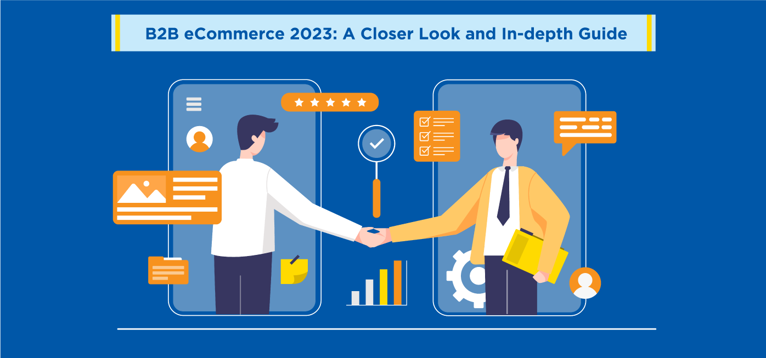B2B eCommerce industry is reaching new heights every passing day.
According to Gartner’s forecast report, 80% of global B2B sales transactions will happen via online channels by 2025.
It all started with Alibaba and Amazon for Business proving (now a fact) that businesses dealing with other businesses can get the same online experience as the end consumers.
At first, most B2B businesses were skeptical about the idea. But now that the worldwide B2B eCommerce market has surpassed $14.9 trillion in valuation, every B2B merchant is eager to get a piece of that pie.
And the good news is, even if you’re not familiar with the B2B eCommerce business model, you can still launch a B2B eCommerce store in 2022 and succeed.
This in-depth guide will take you through everything you need to know about B2B eCommerce, including definition, types, benefits, examples, the process of starting your own B2B eCommerce business, and much more.
With that, let’s jump right in!
What is B2B eCommerce?
B2B eCommerce is a transactional process in which a business sells goods or services to another business online via an eCommerce website.
Unlike the B2C eCommerce model where online businesses sell directly to the end consumers, B2B eCommerce transactions usually happen between:
- Manufacturers and distributors
- Distributors and wholesalers
- Wholesalers and Retailers/Resellers
…through an eCommerce store.
It typically involves selling high volumes of product(s) so that businesses can purchase their inventory in bulk. And when this B2B sale happens via a digital channel, it is referred to as B2B eCommerce.
Types of B2B eCommerce
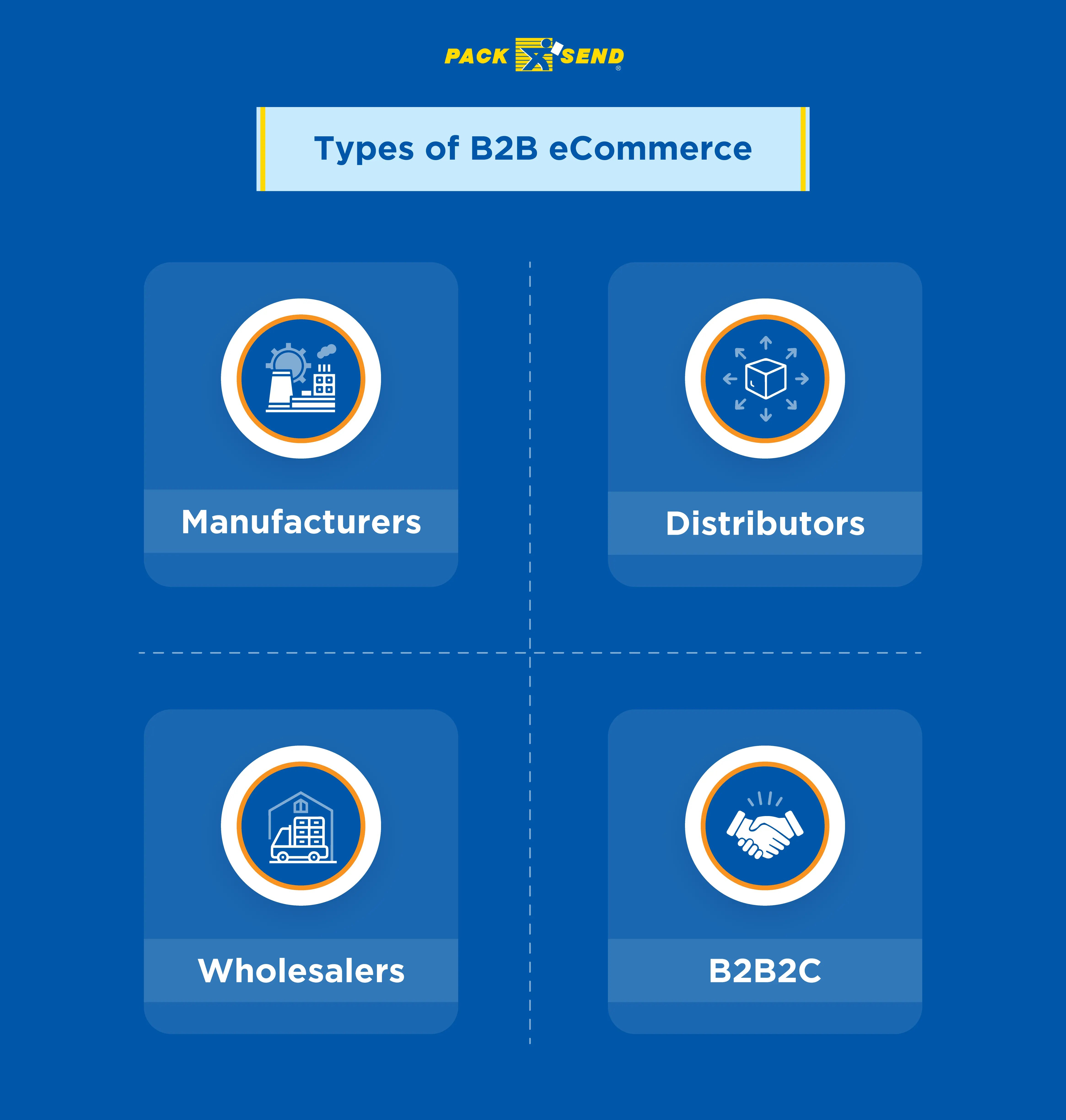
When it comes to B2B eCommerce, the transaction can happen in a variety of ways.
Plus, each type of B2B eCommerce requires a specific solution. This largely depends upon various factors such as the products you sell, who you sell them to, and your geographic location.
For instance, if you sell fresh produce in bulk, your ideal B2B customers would likely be local retailers or resellers.
On the other hand, if you manufacture electronic products, you could easily target electronic goods distributors & wholesalers across the globe.
But no matter what type of B2B business you run, you’re likely to fall into one of the following B2B eCommerce categories.
1 - Manufacturers
Manufacturers, as you might already know, produce finished goods at a massive scale by utilising raw materials along with manual labour as well as machines. The finished goods are then sold to either other manufacturers or distributors in a typical B2B model.
The auto industry is a perfect example of this type of B2B model.
The manufacturer usually builds several types of car parts like engine, transmission, radiator, etc.
Then, they sell it to automobile companies that assemble the entire car using the purchased car parts and sell it to consumers.
However, B2B buyers’ expectations are shifting. Just like B2C customers, B2B buyers are now also demanding online buying options.
So, if you’re a B2B manufacturer, it’s essential to stay up to pace with B2B buyers’ expectations to succeed in the industry.
2 - Distributors
Once the finished goods are ready, manufacturers are left with two options:
- Sell directly to consumers - Manufacturers prefer this option when they want to have control over the selling aspect of their produced goods. However, taking this route involves additional responsibilities such as managing orders, packaging, shipping, and also marketing.
- Sell to distributors - Manufacturers can partner with distributors who sell their products for them. Taking this route usually requires distributors to work closely with the partnered manufacturer & bring visibility to the produced goods with the aim to increase sales.
A good example of this is small business owners buying a large volume of Tupperware products at cheaper prices and selling them locally.
Statistically, there is a massive potential for B2B eCommerce distributors to achieve extraordinary growth.
According to a source, the adoption rate of B2B eCommerce distribution increased by a whopping 26.3% between 2019 and 2020.
3 - Wholesalers
B2B wholesale businesses often buy goods in bulk directly from manufacturers or distributors for a lower price and sell them at retail value.
This form of the B2B model, where the sale of goods first occurs between two businesses and then reaches retailers, is called wholesale.
Companies like BJ’s and Sam’s Club are perfect examples of this. Both these companies buy products directly from manufacturers in bulk and sell them directly to the consumers at cheaper prices than their retail value.
And in B2B wholesale eCommerce, this entire transaction happens online using a B2B eCommerce platform.
Unlike traditional wholesale B2B transactions that occur via email, phone, or in-person meeting, the wholesale B2B eCommerce platform allows the wholesalers to display products more intuitively on an eCommerce website and provides a seamless buying experience.
4 - B2B2C
As the name suggests, the business-to-business-to-consumer model removes the middleman and puts businesses directly in touch with consumers.
In the typical B2B2C model, the manufacturer or wholesaler can reach the end consumer by either partnering with a B2B business or selling directly to the end consumers.
And when this entire process is moved online, it is referred to as the B2B2C eCommerce.
In many B2B2C eCommerce models, the end consumers usually know that they’re getting products from a business that’s separate from the business that manufactured it.
For example, a consumer may buy a product from an influencer while knowing that the product is built and sent by its original manufacturer.
With that, you’ve now learned about the different types of B2B eCommerce models. Next, let’s dig a little deeper and explore the benefits of B2B eCommerce as well.
Benefits of Starting B2B eCommerce Business
Let’s go through some of the key benefits of starting your own B2B eCommerce business.
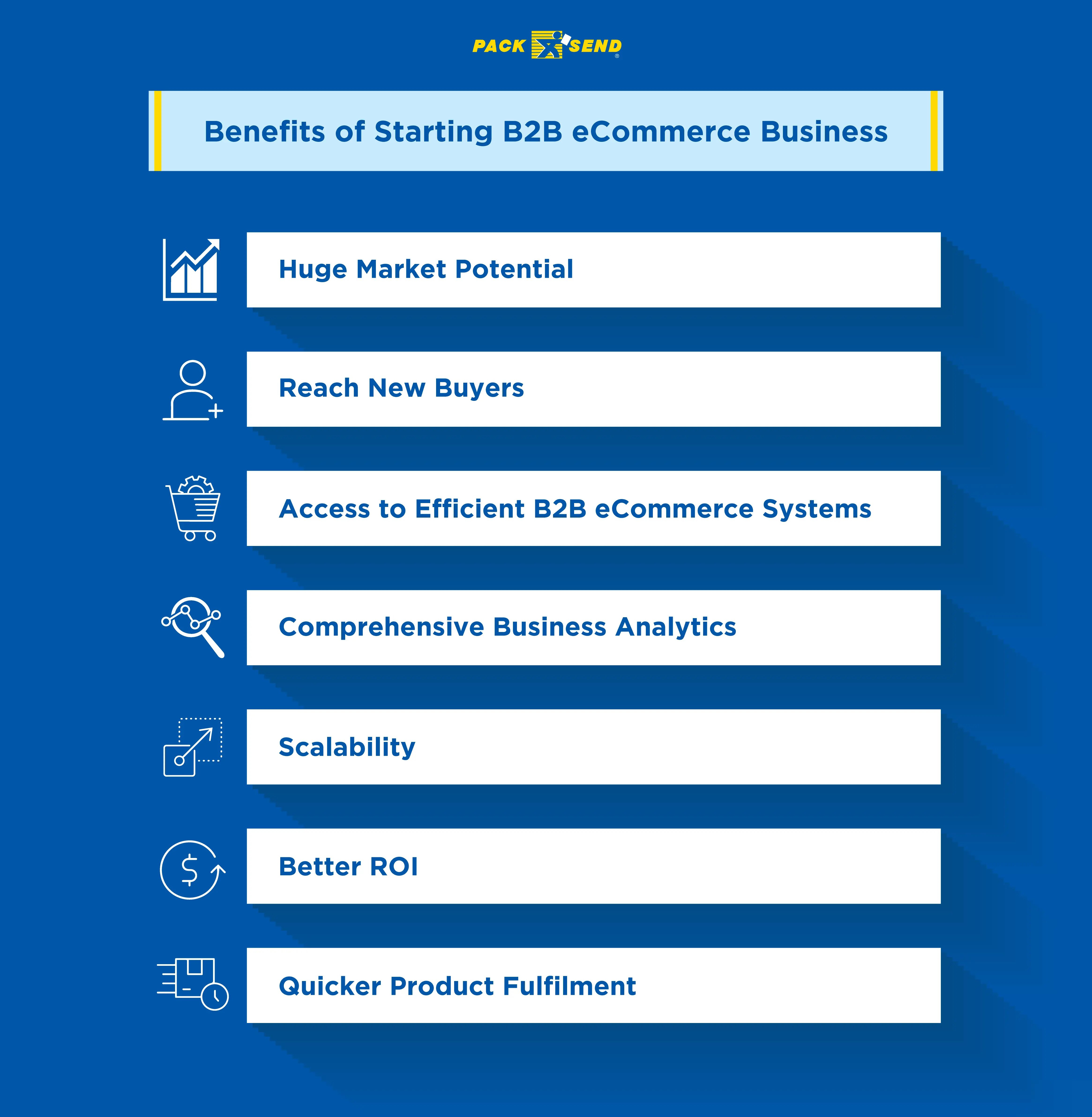
Huge Market Potential
The B2B eCommerce market is growing at an unprecedented rate. According to a study, the global B2B eCommerce market is forecasted to reach 25.65 trillion by the year 2028.
One of the main reasons for this massive growth is because B2B buyers now prefer to shop online due to its convenience.
In other words, B2B sales are increasingly shifting towards online platforms. So, if you want to remain competitive, you must fulfil digital buyers’ expectations.
Reach New Buyers
The way consumers shop these days has completely changed. Nowadays, they want to research and purchase online. And the same goes for B2B purchases as well.
According to a report by Merit B2B, millennials are increasingly taking on decision-making roles in their organisations that give them the ability to make business purchases online.
The point is, B2B eCommerce has made it easier to establish a strong online presence and reach new buyers via search engines.
Access to Efficient B2B eCommerce Systems
If you already run a traditional B2B business of some sort, you can easily integrate your eCommerce website with your current ERP system and eliminate the need for paper-based processes.
Thus, decreasing the time as well as resources required for performing administrative duties.
Furthermore, eCommerce integration will empower your ERP system to automatically create detailed sales statistics, order totals, profit percentages, discounts, and overall revenue.
Plus, you can also integrate your B2B eCommerce website with your customers’ procurement system to win new clients as well as retain existing ones.
Scalability
A B2B eCommerce website allows you to scale your business in response to the market demand.
So, whether you already have an existing B2B business or starting a B2B eCommerce business from scratch, you can easily handle any complexities and meet your customers’ demands by scaling as and when required.
Comprehensive Business Analytics
Data is a crucial part of any B2B business. Fortunately, all eCommerce platforms allow you to collect, analyse, and measure core business data and learn from it.
This data usually includes your sales, customer engagement metrics, customer retention, conversion rate, and more.
Furthermore, the insights obtained from the analysis can help to gain an in-depth understanding of your customers’ preferences and their changing demands.
Better ROI
A further benefit of launching a B2B eCommerce business is its potential for growth in terms of sales & revenue while minimising costs and achieving a better ROI.
The B2B eCommerce model allows you to achieve this by taking the most parts of your business online such as streamlining and automating core business processes, which in turn boosts business efficiency and eliminates unnecessary costs.
Quicker Product Fulfilment
An eCommerce store not only makes the sales process more efficient but also ramps up the buying process for buyers.
Put another way, by building an eCommerce store for your B2B business, you can automate inventory updates & product fulfillments, and manage complex orders with ease.
This results in a fast, accurate, and transparent delivery experience that leads to happy and satisfied customers.
That said, if these benefits still haven’t fully convinced you, the following examples of successful B2B eCommerce adoption surely will.
B2B eCommerce Examples
The concept of B2B eCommerce is not new. Since its arrival, all kinds of B2B businesses have adopted it to suit their business needs and fulfil their customers’ requirements.
Below are a few examples of B2B eCommerce companies that have successfully adopted and utilised the B2B eCommerce concept to their advantage.
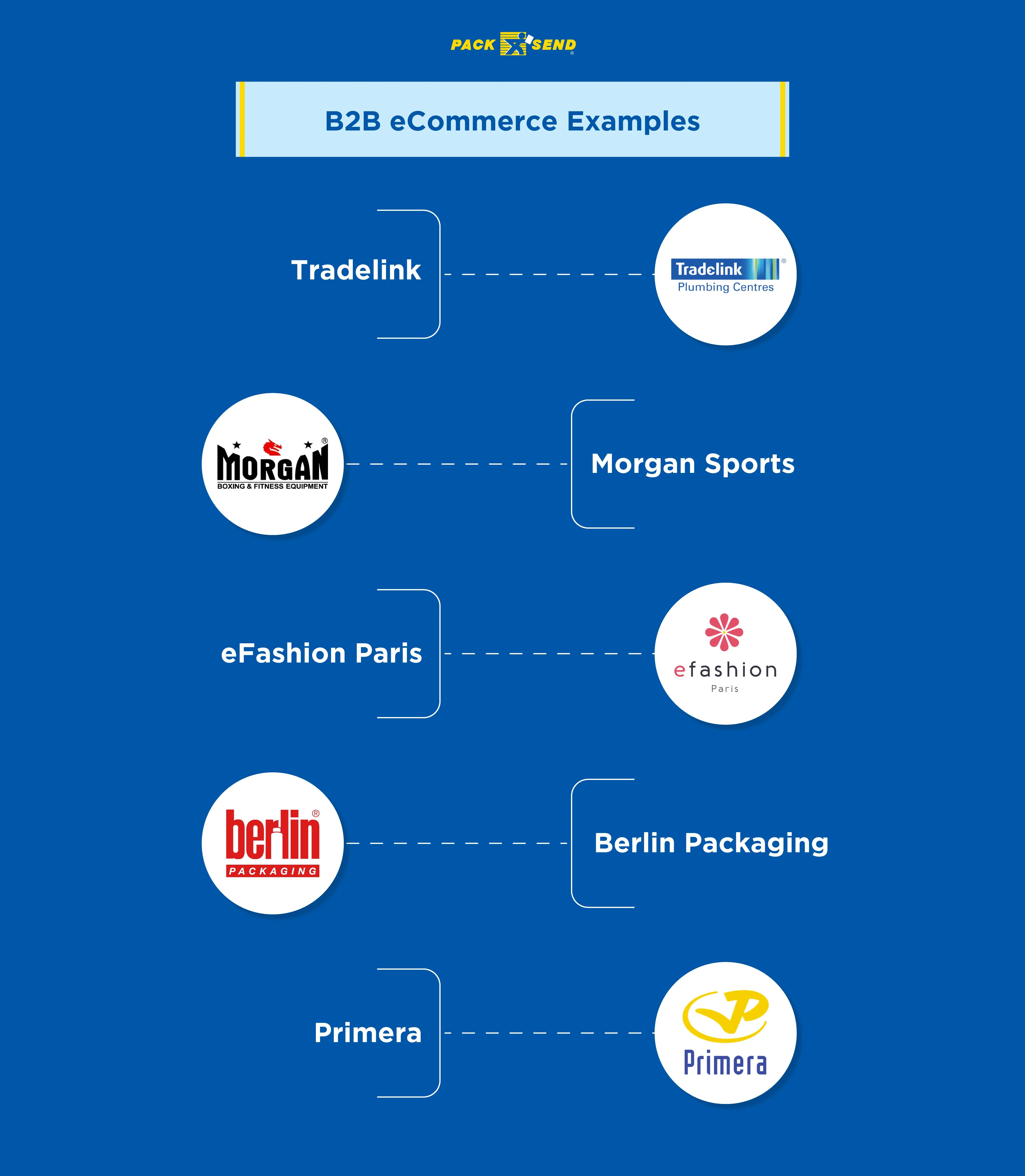
Tradelink
Tradelink is Australia’s oldest plumbing company with over 200 branches across the country, 300 cars in operation, and over 1,300 employees serving its customers.
With the advent of eCommerce technologies, the company wanted to modernise its services.
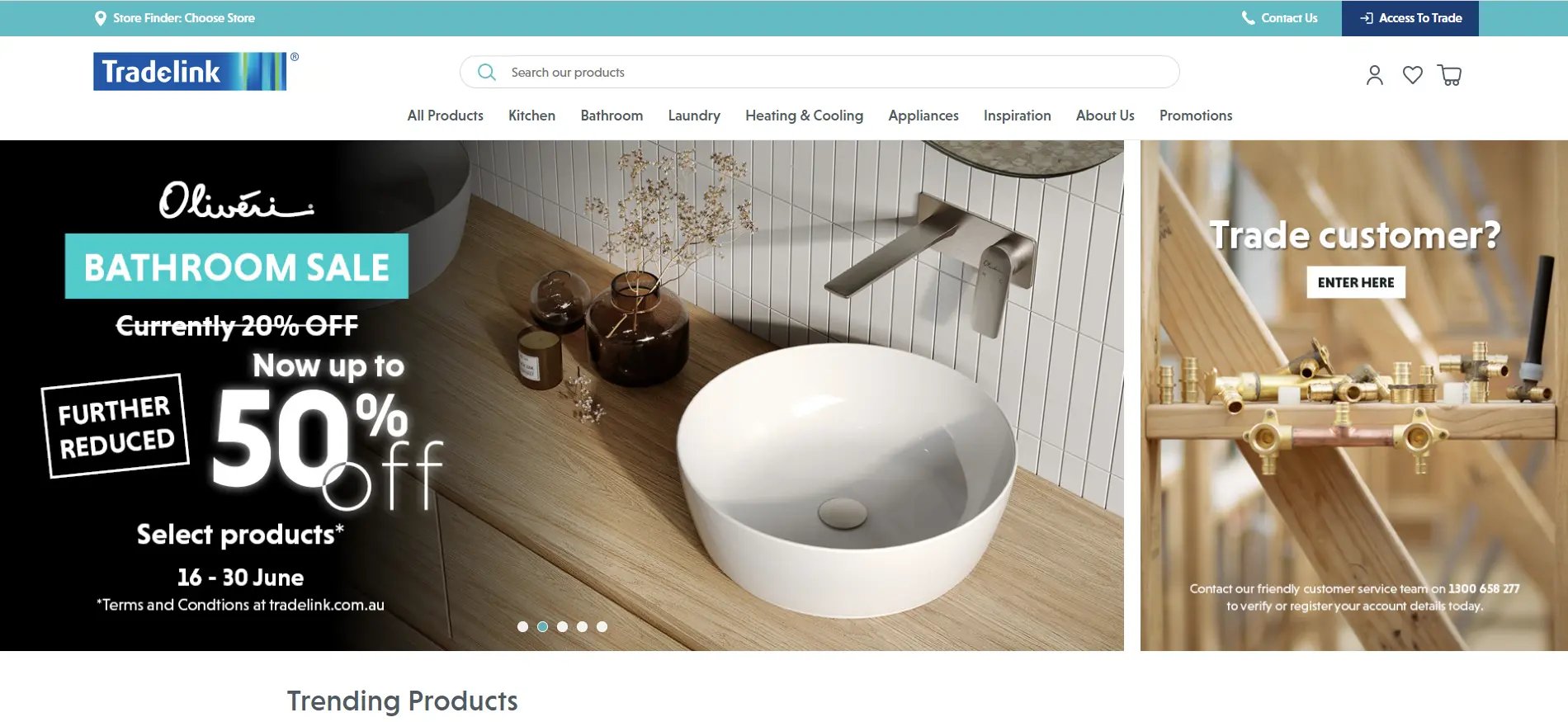
Soon after migrating to the B2B eCommerce business model using BigCommerce, Tradelink witnessed a 346% increase in customers, 373% increase in total orders, and 338% increase in overall revenue in a span of 6 months.
Morgan Sports
Morgan Sports is a leading B2B supplier of boxing and fitness equipment in Australia.
Like many other B2B eCommerce businesses, Morgan Sports never sells its products directly to consumers.
In fact, in order to qualify for a wholesale account, customers need to be either coaches, personal trainers, yoga instructors, fitness retailers, gym owners, non-profits, or government organisations.
And unless you’re logged in to your wholesale account, all product prices stay hidden on Morgan Sports eCommerce website.
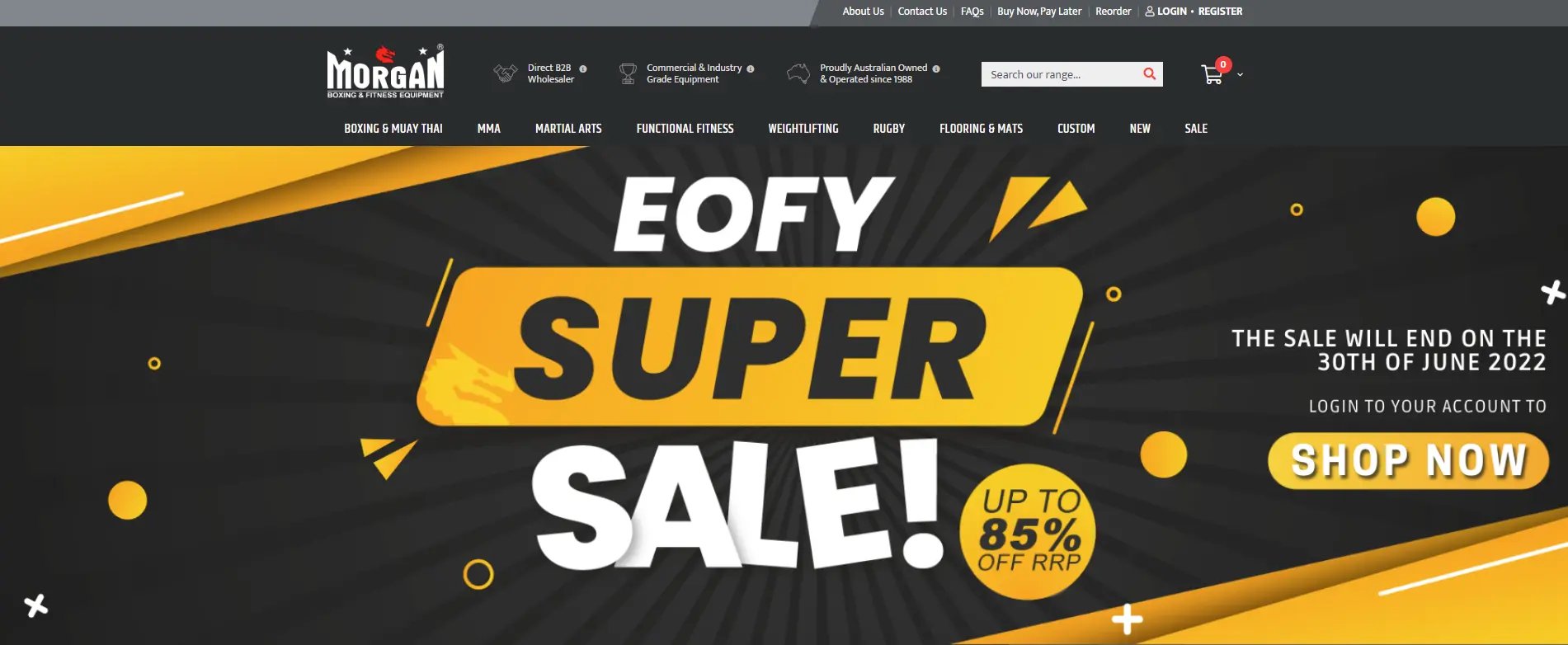
Overall, the company has successfully established its B2B eCommerce presence across Australia as well as around the world with over 7,500 businesses using Morgan Sports for their boxing and fitness equipment needs.
eFashion Paris
eFashion Paris is another prime example of B2B eCommerce.
The company started in 2011 with the focus on helping retailers connect with wholesalers and place their orders online in all transparency with a few clicks just like they usually do in a traditional B2B model.
To achieve this, eFashion Paris started uploading dozens (sometimes hundreds) of new items from its wholesalers on an everyday basis.
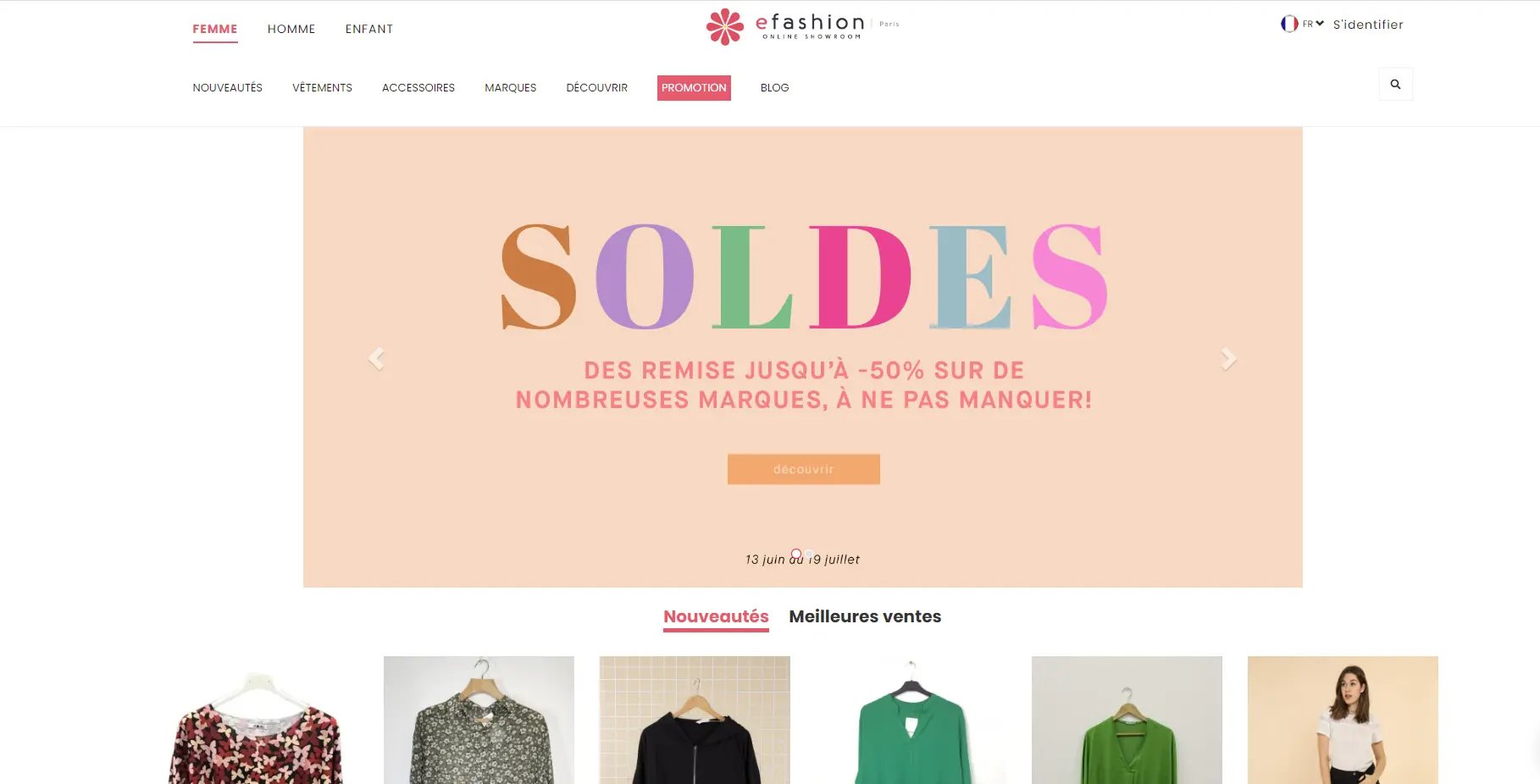
And eventually, the company successfully eliminated the need for retailers to get out of their offices and travel to view & order the latest fashion items from wholesalers in Paris and Aubervilliers.
In a nutshell, eFashion Paris is a perfect B2B eCommerce example that successfully figured out what its customers need and provided an effortless way for them to find the right products.
Berlin Packaging
Berlin Packaging is a family-run business since 1938 that has established an unbeatable presence across the globe.
What started as a local tin plate packing service provider has evolved into a mammoth corporation serving almost every industry imaginable, fulfilling its modern glass and plastic container packaging needs.
Today, they fulfil B2B packaging orders for a huge range of businesses around the world. To manage such a fairly complex operation efficiently and effectively, the company decided to opt for a B2B eCommerce solution.
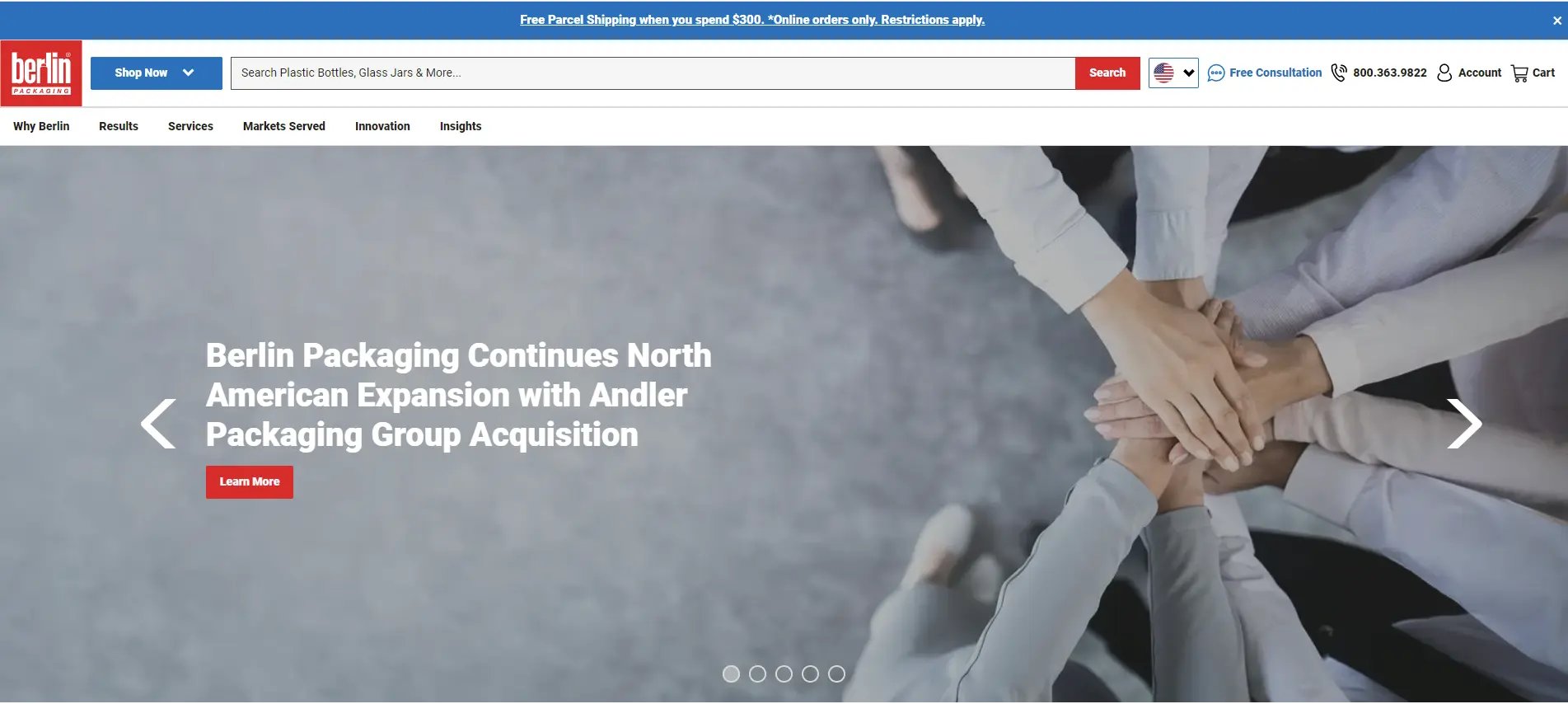
Since making the switch to B2B eCommerce, Berlin Packaging has witnessed substantial growth in its overall conversion rate. Additionally, the company also observed a notable increase in total orders as well as overall revenue of the business.
Primera
Primera’s eCommerce site is another noteworthy example of a B2B eCommerce.
The company is one of the world’s leading developers and manufacturers of speciality printers such as colour label printers, label applicators, slide & cassette printers, and print accessories.
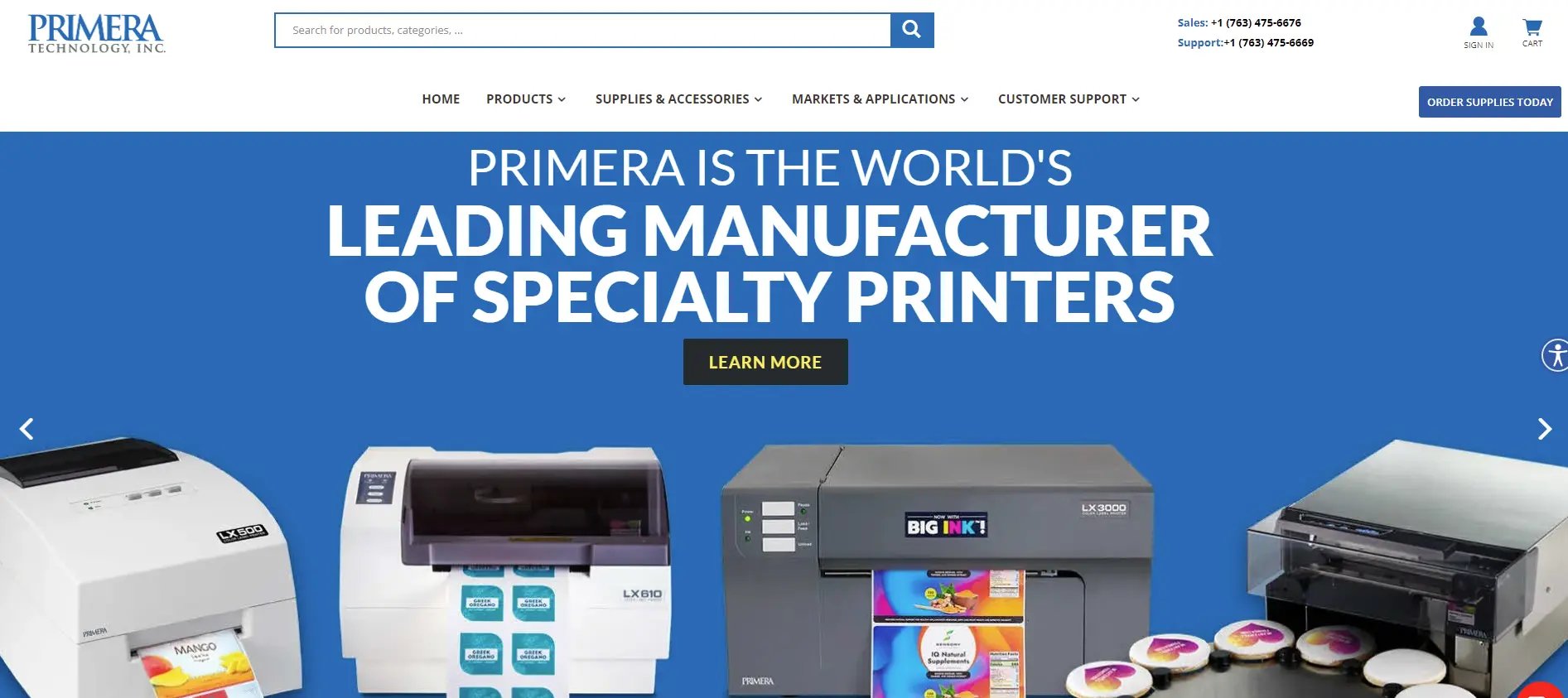
They cater to TV stations, medical institutions, universities, wineries, coffee manufacturers, non-profit organisations, and more for their printing equipment needs.
Today, Primera sells its products in over 200 countries worldwide through its carefully-engineered B2B eCommerce website and has established itself as a vastly successful B2B eCommerce brand.
And guess what?
It’s now your turn to capitalise on the B2B eCommerce model by starting your very own B2B eCommerce venture.
How to Start a B2B eCommerce Venture
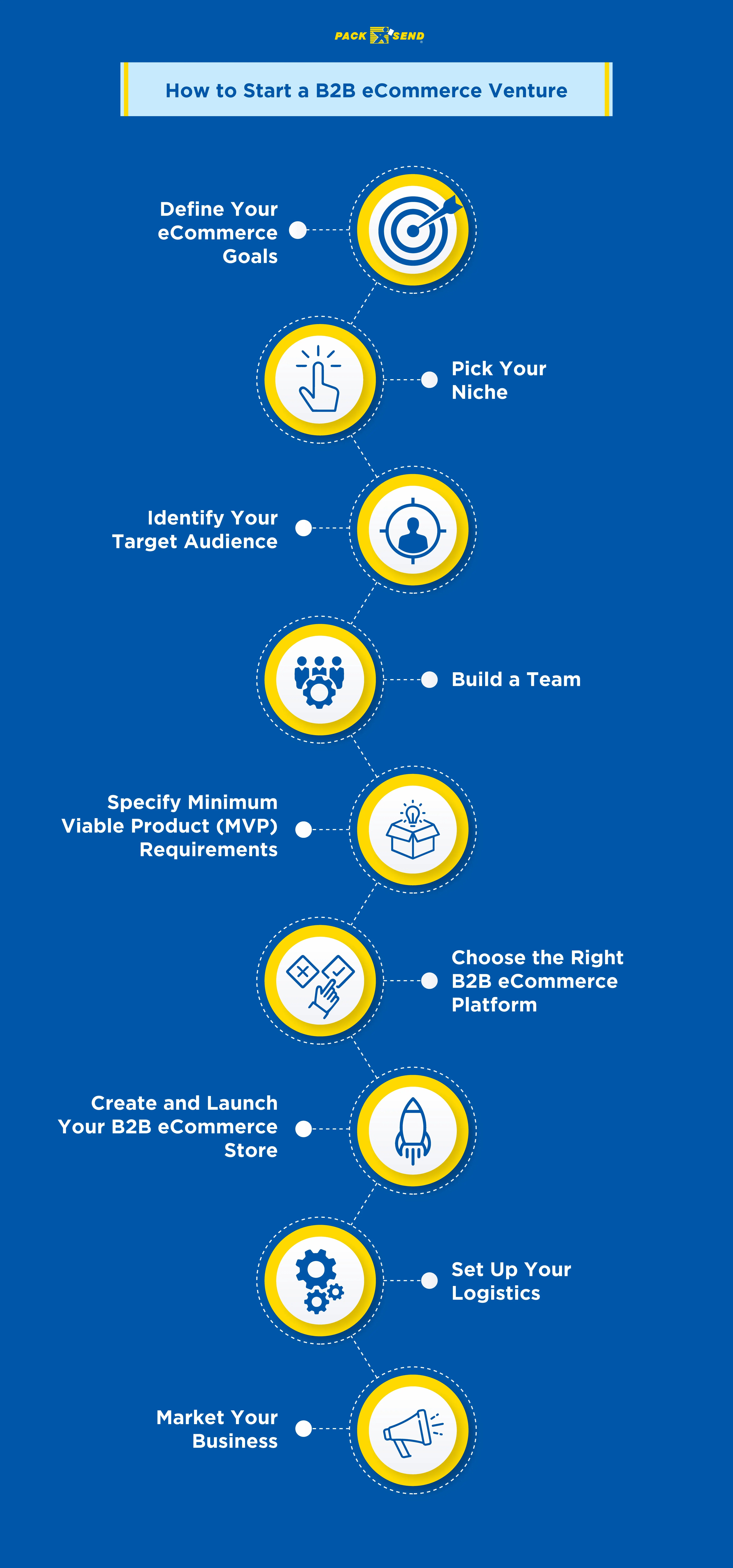
Starting a B2B eCommerce business is most certainly difficult, but not impossible.
Every successful B2B eCommerce venture starts with thorough planning, consistent execution, and following a precise process.
Below, we’ve shared that precise process in 9 steps that will help you to launch a successful B2B eCommerce business from scratch.
So without any further ado, let’s dive right in.
1 - Define Your eCommerce Goals
Before you jump into the technical nitty-gritty of your B2B eCommerce development, it’s best to start from the beginning. i.e.: define your eCommerce goals.
The first thing you need to do to determine your eCommerce business goals is to ask a few questions such as:
- Why do you want to start a B2B eCommerce business?
- What are you aiming to achieve by launching a B2B eCommerce website?
- What are the advantages of starting a B2B eCommerce venture?
- What does B2B eCommerce success look like to you?
Answering these questions will help you to articulate exactly what you want to achieve and how you want to achieve it.
2 - Pick Your Niche
Once you’ve defined your B2B eCommerce business goals, the next step you need to take is to pick your niche.
A niche is basically an area of expertise in which your business is specialised.
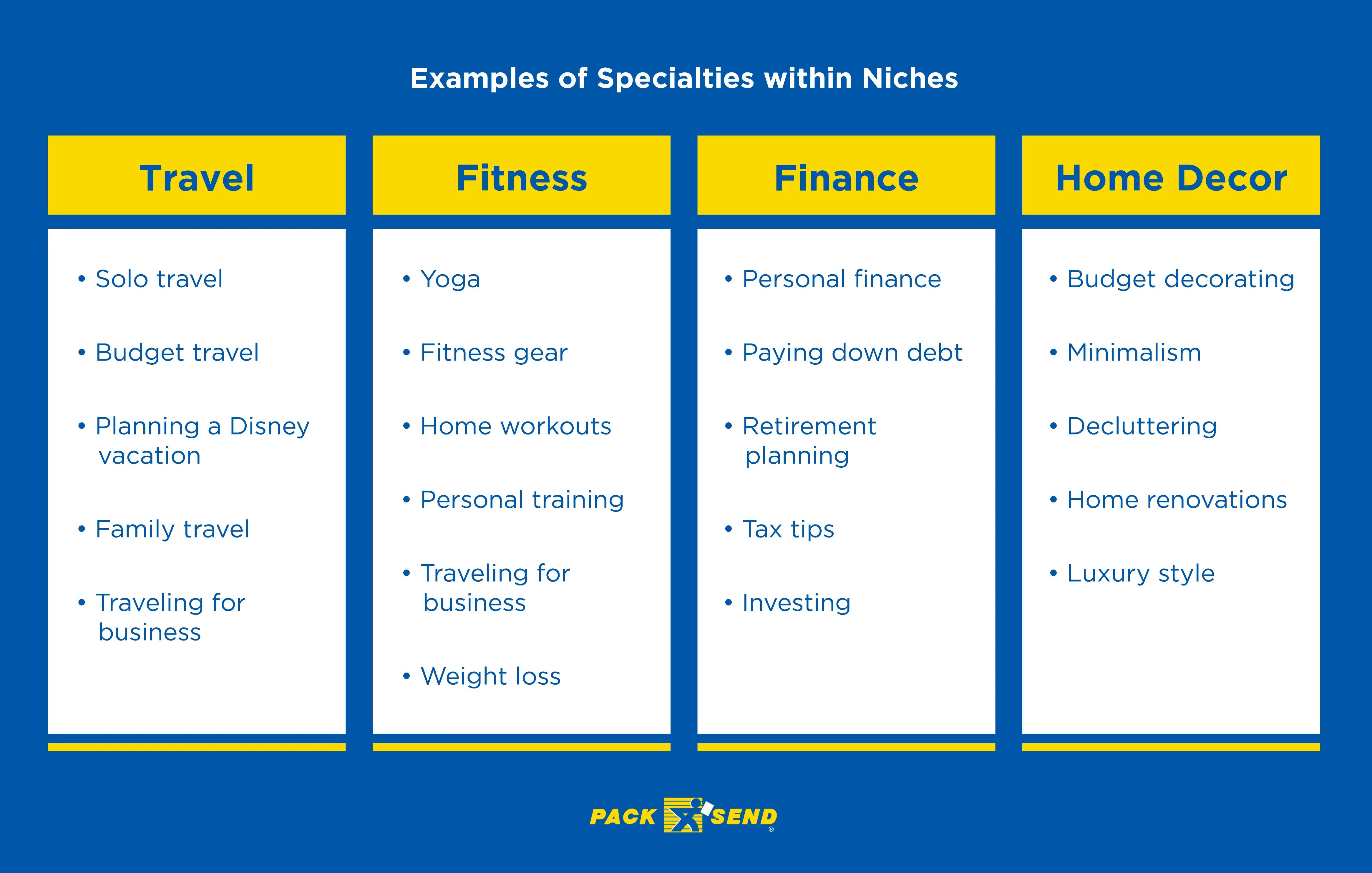
As you can see, there is an abundance of niche options in almost every industry.
What you need to do is, find a specific market that you’re expert & specialised in, you can serve better than others, and is profitable in the long run.
Although if you already run a traditional B2B business, your niche will already be defined. And you’re most likely planning to expand your business to new markets.
Conversely, if you’re planning to launch a brand-new B2B eCommerce business, you need to pick a niche from the very beginning.
The reason is that having a focused niche allows you to easily identify your target audience, which brings us to the next point!
3 - Identify Your Target Audience
Identifying your target audience is a vital part of a B2B eCommerce business strategy. It helps to lay the foundation of the overall marketing strategy.
In simple words, identifying your target audience helps to determine where to focus your marketing and sales efforts.
Furthermore, it also helps to discover who your potential customers are, where they hang out, what they care about, and their biggest pain points.
The quickest way to identify your target audience is by answering a few basic questions such as:
- What is your B2B eCommerce niche?
- What do you want to sell online?
- Who do you want to sell to?
- What core pain points your B2B business solves?
Answering the above questions will help to easily identify your target audience.
4 - Build a Team
After identifying your target audience, the next step is to build a team that will carry out your B2B eCommerce development project.
Depending on your business size, your eCommerce team can take various shapes. But one thing that’s requisite for building a winning eCommerce team is appointing an eCommerce manager.
This person should be able to take charge and be responsible for getting people together and moving them in the same direction.
In addition, the appointed manager must also involve stakeholders from every department in your business to bring essential knowledge, skills, and expertise to the table.
The point is, you need to choose your team members wisely as they’ll be defining the quality of development approach and methodology, which is essential for a successful B2B eCommerce store development.
5 - Specify Minimum Viable Product (MVP) Requirements
Once you have a team in place, it’s time to define your MVP requirements.
Minimum viable product, or its abbreviation MVP, is a concept from a book called ‘Lean Startup’.
It emphasises on building a version of your product/software/website with only essential features to be used by early customers.
The purpose of building MVP is to obtain feedback from early customers/users for additional customisation and feature(s) development.
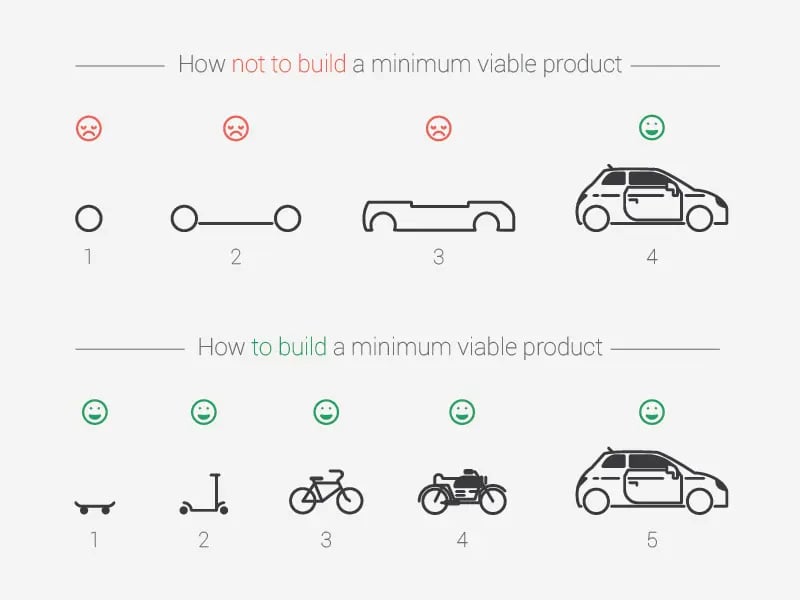
To define your B2B eCommerce MVP requirements, think about the minimum features and functionalities that will be required to satisfy your customers.
Here’s a quick checklist to define your B2B eCommerce MVP requirements:
- Make sure they align with your eCommerce goals.
- Only build features and functionalities that you plan to use within the first year.
- Set realistic goals on how much you can accomplish with your available resources.
- Validate that it solves the common core pain points of your customers.
- Most importantly, prefer integrating standard third-party features instead of looking into costly options for MVP development
If you’re still unable to decide which features to include in your B2B eCommerce MVP, here is a list of essential B2B eCommerce features for you to consider:
- Customer registration & login
- Multi-user account
- Responsive design
- Product catalogue & detailed product info pages
- Bulk order & re-order functionalities
- One-step checkout
- Secure & flexible payment options
- Discount & customer loyalty program
- Advanced search
- Customer support channel(s)
6 - Choose the Right B2B eCommerce Platform
Once you’ve finalised the MVP requirements for your B2B eCommerce store, the next step is to choose a B2B eCommerce platform to build your store upon.
Now there are several eCommerce platforms in the market that offer similar features with little or no differences.
However, it is highly recommended to analyse the specific features of each platform before you invest to make sure that it is an ideal match for your business model.
Following are the key features to look for in a B2B eCommerce platform:
1. Personalised Experience
A personalised experience is one of the most distinct features to have in a B2B eCommerce store. According to an Accenture report, 73% of B2B leaders have said that B2B buyers’ expectations for personalised experiences are already higher today than it was a couple of years ago.
Unfortunately, the majority of B2B eCommerce stores fail to provide personalised experiences and instead design their store based on standard templates.
But unlike them, you should choose a platform that best fits your specific business requirements and lets you create personalised experiences.
2. Responsive Design
Responsive design is not just another must-have for B2B platforms, all kinds of eCommerce platforms should support it.
The simple reason is that responsive design renders your content properly across all devices and screen sizes.
3. Flexible Payment Options
Flexible payment options is another essential feature to look for in your ideal B2B platform.
This is crucial because B2B transactions are complex, which is why offering various flexible payment methods along with instalment options can definitely result in a better customer experience.
4. Restricted Access
Many B2B eCommerce businesses, like Morgan Sports we mentioned earlier, restrict access to certain parts of their store to unregistered customers.
In fact, they even pass their potential customers through a vetting process before approving their accounts.
Similarly, if you plan to restrict access to certain parts of your B2B eCommerce store to unregistered customers, be sure to choose a platform that supports that functionality.
5. Integration with Other Systems
In addition to the features mentioned above, you should ideally choose a B2B eCommerce platform that can be easily integrated with your other systems.
Doing so will help to establish a harmonious environment between your online and offline channels.
In addition, a well-integrated B2B eCommerce store will turn you into a more efficient, multi-channel business, yielding a better customer experience & ROI.
7 - Create and Launch Your B2B eCommerce Store
You’re now more than halfway there to starting your own B2B eCommerce store. Now it’s time to actually start the development of your B2B eCommerce store and prepare for its launch.
One piece of advice though! Before you begin the development process, it’s best to get an estimated cost of your entire project to get an idea about how much budget you need to set aside.
Simultaneously, you should also plan for the type of launch you’re planning for your brand-new B2B eCommerce store.
For example, you can go with either a soft launch approach which involves launching your store to a local or a limited geographical area.
Or, you can go with the hard launch which involves executing a massive marketing campaign to reach your entire target audience all at once.
8 - Set Up Your Logistics
Managing logistics is one of the greatest challenges an eCommerce company faces, especially in the B2B industry. This is especially true because of the responsibility of handling large shipments that often come at high costs and long delivery times.
To combat this, you must set up your B2B logistics in a way that can deliver fast and efficient shipping to your buyers while maintaining an affordable price band.
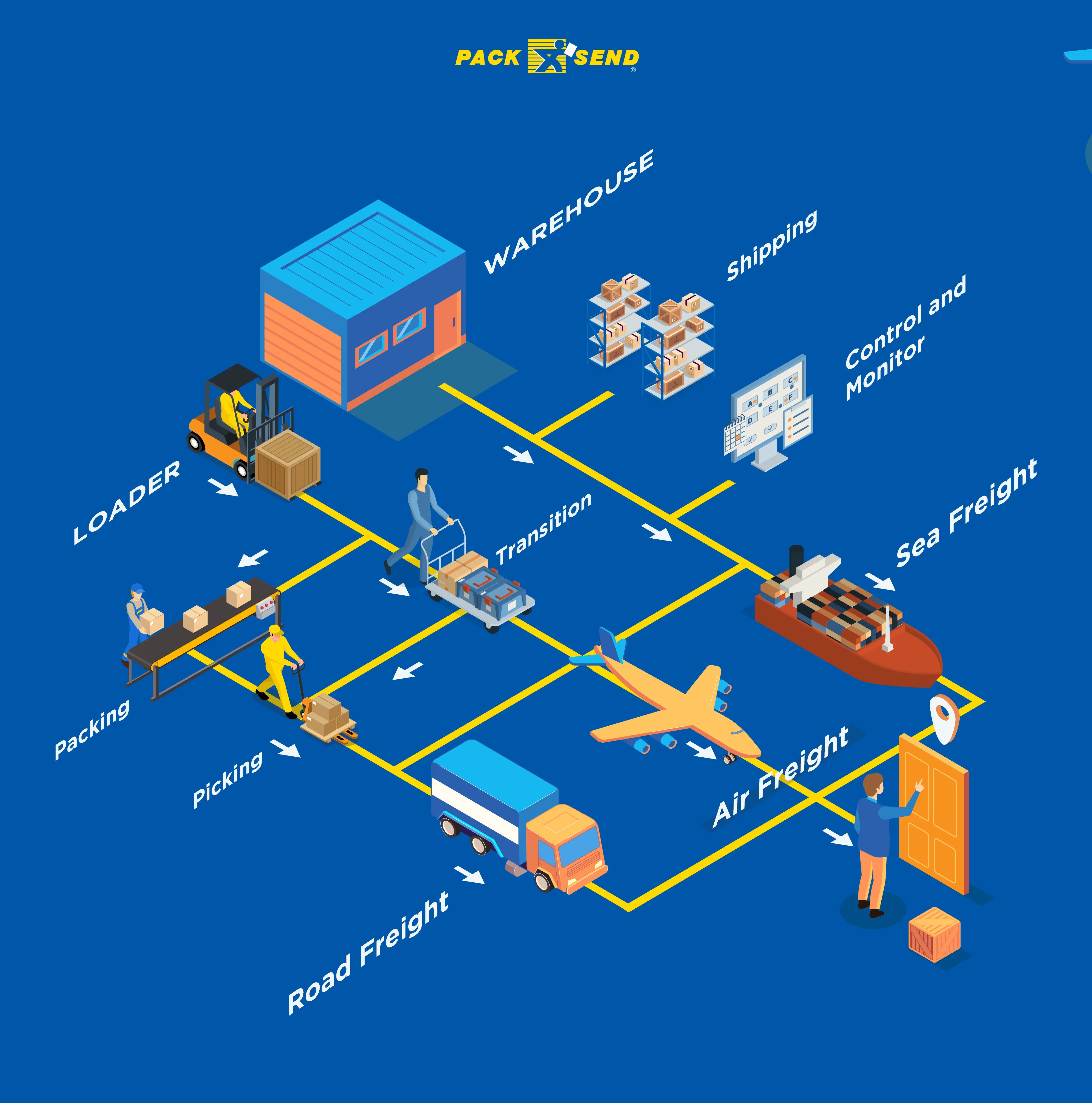
One way to achieve this is by partnering with a reliable eCommerce order fulfilment company to automate the entire logistics aspect of your B2B eCommerce business.
Apart from this, many B2B eCommerce businesses have even started to integrate an in-built shipping cost calculator to allow their customers to calculate shipping costs before placing their orders.
The point is, along with your eCommerce store launch, your logistics must be set in a certain way that ensures efficient & on-time delivery of shipments.
9 - Market Your Business
By now, you’ve taken care of almost every aspect of your B2B eCommerce business. - Your eCommerce store is live, the logistics part of your business has been addressed, and the only thing that needs your attention is marketing.
After all, how else would your potential customers will know about your B2B eCommerce venture, right?
The B2B eCommerce marketing strategy varies depending on your specific business goals. There are, however, a few common channels that will help you build a strong foundation such as:
- SEO
Search Engine Optimisation is one of the most effective marketing strategies of all time. Although achieving desirable results can take some patience and hard work since it consists of executing on-page SEO, off-page SEO, and technical SEO.
But on the surface, it mostly involves creating different types of high-quality & unique content (blogs, infographics, videos, etc.) and optimising the web pages around the primary keywords to attain higher rankings in SERPs.
- Paid Marketing
If you can spend a slice of your overall marketing budget on advertising, you should definitely give paid marketing a try.
There are multiple avenues of paid marketing such as pay-per-click, sponsored banner ads, launching an affiliate program, etc.
- Social Media Marketing
Social media marketing has proven to be an effective channel to bring in new customers for all kinds of businesses, including B2B eCommerce websites.
In fact, leveraging social networks, especially after launching a brand new B2B eCommerce store, is extremely crucial for building and spreading brand awareness.
With that, you’ve finally launched your B2B eCommerce business and marketed it well. But it’s not the end of the post here!
Throughout your journey, you’ll face different challenges at various stages that you’ll have to address and resolve for establishing a successful B2B eCommerce venture.
Most Common B2B eCommerce Challenges
Here are some of the most common B2B eCommerce challenges most people face when starting their journey.
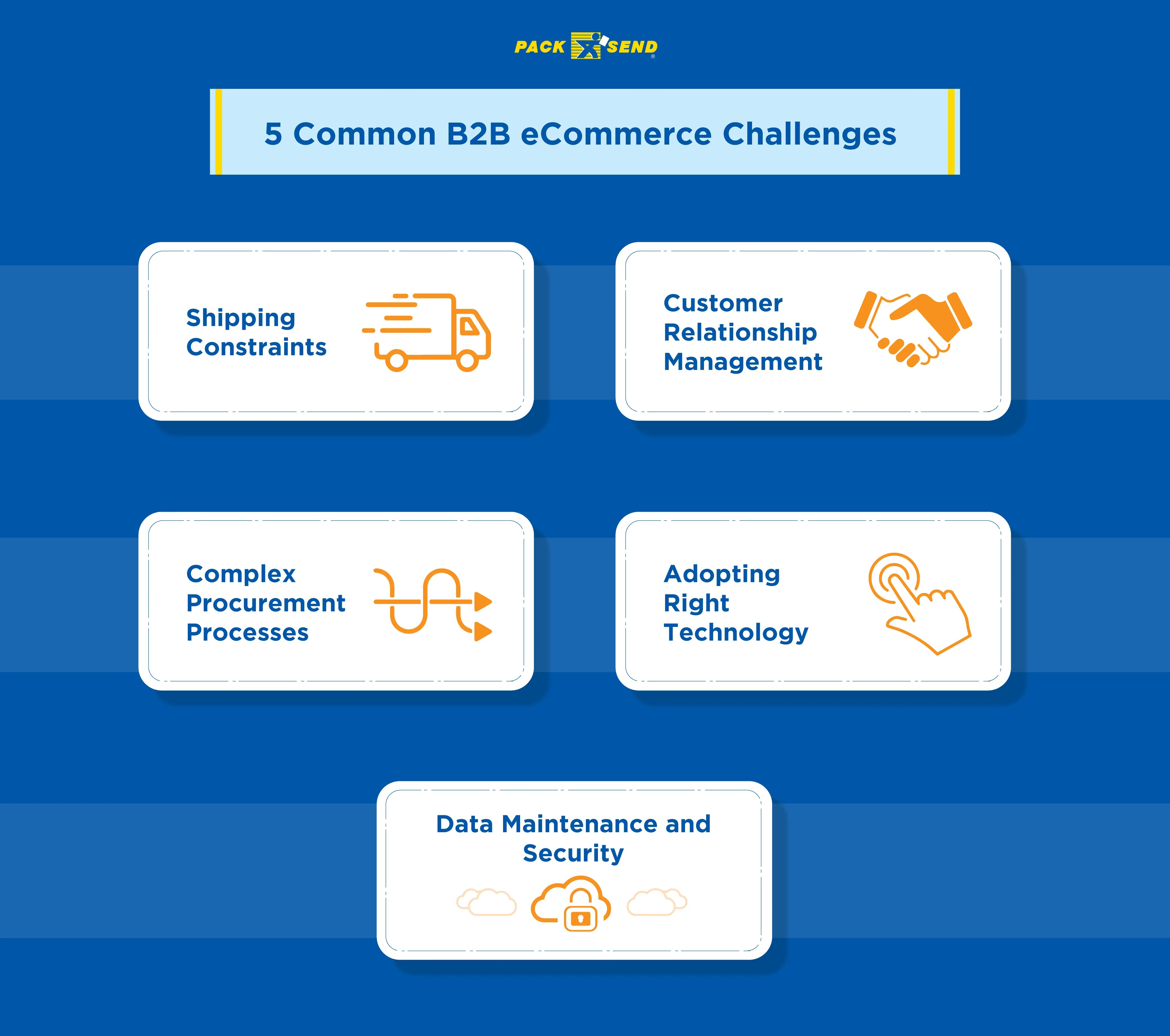
1 - Shipping Constraints
One of the common roadblocks almost every B2B eCommerce business faces in its initial days is determining the best shipping strategy.
Unfortunately, there is no one-size-fits-all solution.
To form a solid shipping strategy, you’ll have to consider multiple factors such as:
- Frequency of repeat orders
- Calculating cost to ship bulky goods
- Estimate shipping costs in real-time
- Managing small shipments in a cost-effective manner
- And so on…
In addition to these factors, B2B buyers now also expect B2C-like experiences such as quick delivery, personalisation, and convenience, adding more complexity to the shipping aspect of a B2B eCommerce business.
Furthermore, complete price transparency, custom-tailored shipping based on product, order, or customer, and multiple shipping options are also becoming a common feature among B2B eCommerce websites.
2 - Customer Relationship Management
Another biggest challenge B2B eCommerce businesses face is building, nurturing, and maintaining customer relationships.
According to a report, 84% of B2B buyers prefer shopping from a supplier whom they have a strong relationship with, even if the competition is offering more favourable terms.
Plus, the lifetime value of a B2B buyer is comparatively much higher than a B2B buyer, making it even more crucial to build positive relationships with your customers.
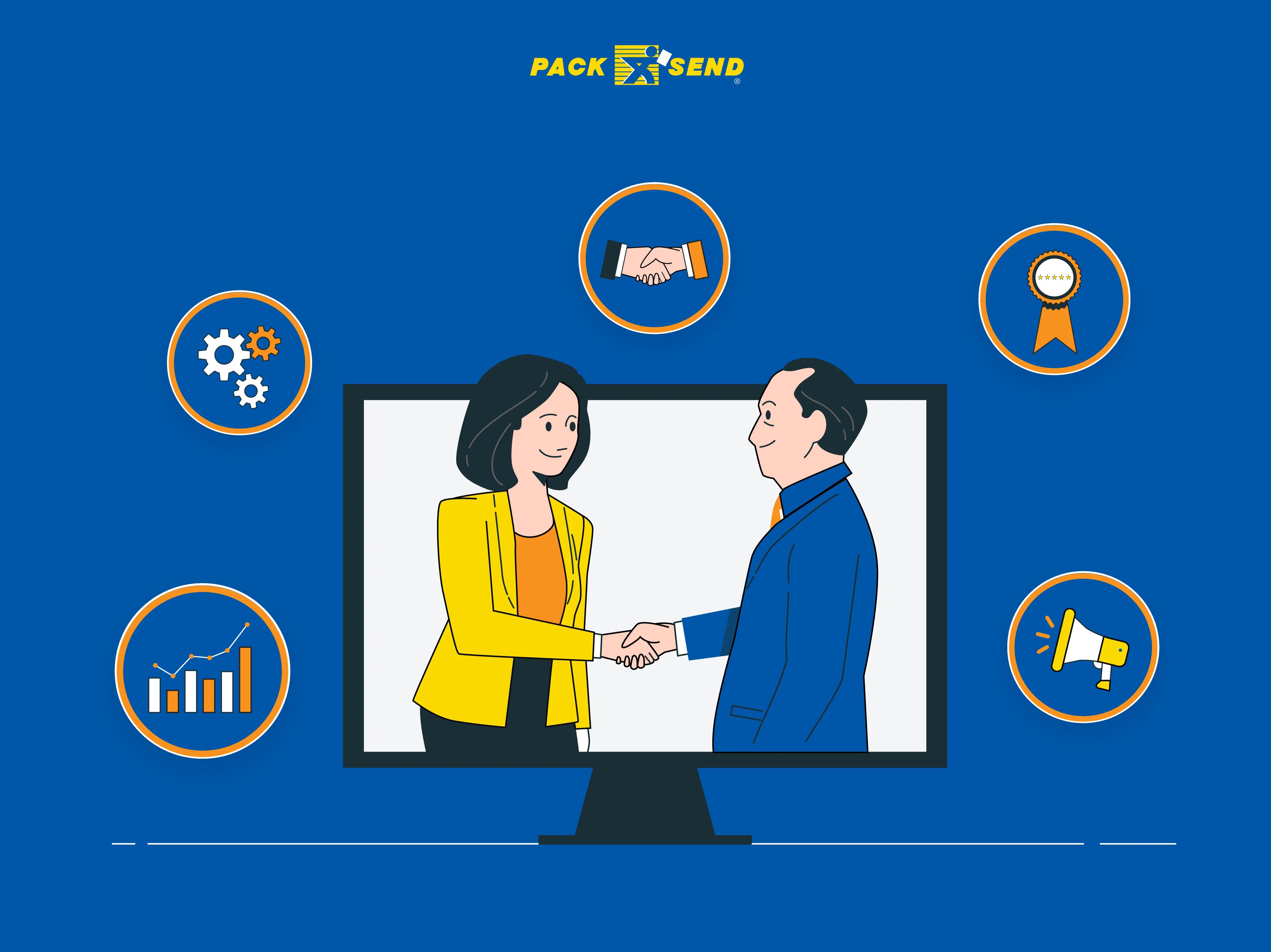
One way to foster healthy relationships with your potential B2B buyers is by providing an exceptional customer experience.
This includes building a fast and easy-to-navigate eCommerce store that is transparent and gives accurate information to your customers.
3 - Complex Procurement Processes
Procurement basically refers to the activities that need to be executed for acquiring products and services that support business operations.
It is often closely monitored as well as controlled with strictly defined policies & processes.
Thanks to advancing eCommerce technologies, B2B buyers now demand flexibility for how they order and how they make payments for their orders.
And if you think about it, they also actually need it due to the complex and analog business processes of their own.
According to a 2019 survey of B2B Buyers, nearly three-quarters of B2B buyers switch to a new eCommerce website that provides better purchasing options. They also said that they would make more purchases if the eCommerce store provides an option to pay by invoice.
4 - Adopting Right Technology
Technology plays a vital role in the success of your B2B eCommerce store. The right technology will keep your inventory well-organised and ensure your customers are happy & satisfied with your brand.
Consider the following factors when choosing the tech stack for your B2B eCommerce store:
- How the technology will help to make the order process efficient
- Customers’ shopping experience
- If all your team members can easily learn to use and access your software
- The accuracy of inventory and numbers
- Ability to customise and scale as per your business’ growing needs
- How easy it is to fulfil orders quickly and precisely
Unfortunately, many B2B eCommerce businesses don’t choose the right technology that can scale as the sales grow, leading to an expensive revamp of the majority of the eCommerce store while the sales are on the rise.
5 - Data Maintenance and Security
Data maintenance and security is a unique challenge for B2B eCommerce because traditional B2B businesses needn’t have to worry about it in the pre-digital era.
Today, however, that is not the case. To satisfy your potential B2B buyers, it is vital to keep your customers’ data such as names, contact information, address, order history, and payment method information secured.
Unfortunately, not every B2B eCommerce takes the required measures to protect its customers’ data, which results in both the business & its customers paying the price for it.
To make sure it doesn’t happen with your B2B eCommerce business, it’s imperative to take precautionary measures and have the right procedures in place to protect your customers’ data from cyber attacks.
Furthermore, you should also keep an eye out for any suspicious activity or behaviour, and train your staff members on how to prevent any potential threats.
B2B eCommerce Best Practices
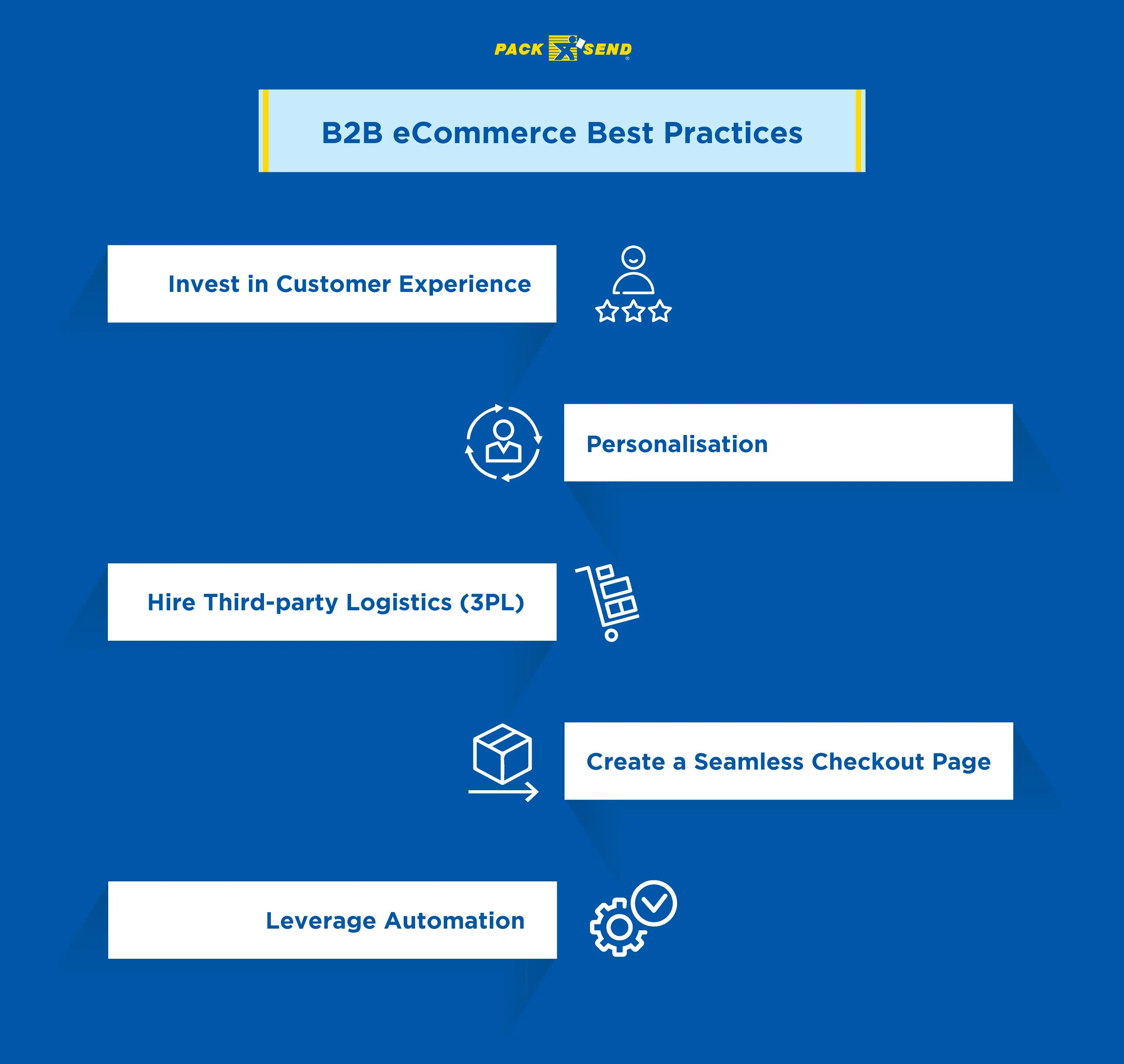
Be it B2B or B2C, ultimately all eCommerce stores have the same goal - Make as many sales as possible.
Moreover, B2B buyers’ expectations have also begun to mimic the end consumers, which begs the question:
Why all B2B eCommerce businesses are not adopting the same practices as B2C eCommerce?
The simple answer is that B2B eCommerce businesses don’t have the same exact linear path to follow as B2C eCommerce sites have.
That’s why all B2B eCommerce sites have to follow slightly different practices.
Here are the best B2B eCommerce practices you can consider adopting in your new B2B eCommerce venture.
Invest in Customer Experience
Like B2C eCommerce, B2B eCommerce businesses that provide exceptional customer experience have the highest chances of success.
Put another way, B2B eCommerce websites with intuitive navigation and robust eCommerce features are more likely to get a bigger piece of the pie (read: market share) and ultimately earn the highest revenue.
Personalisation
Personalisation is another key contributing factor when it comes to providing an exceptional customer experience. It is, in fact, the best practice to ensure everything on your B2B eCommerce site is personalised for each customer.
Doing so will not only help to display targeted, customer-specific promotions based on their purchase history, but it will also help to fulfil market demand with appropriate pricing.
Hire Third-party Logistics (3PL)
Logistics is a hugely undermined yet extremely critical aspect of building a sustainable B2B eCommerce business.
Whether you already run a million-dollar B2B eCommerce business or just starting your B2B eCommerce venture for the first time, if you fail to provide an adequate post-purchase experience, your brand image will take a major hit.
Hiring third-party logistics can take the workload off your shoulders as the entire storing, warehousing, packaging, and delivery of your inventory is handled by an independent entity.

There are a plethora of third-party logistics companies offering micro-fulfilment solutions, distribution of goods, third-party logistics services, and other affordable logistics services at affordable costs.
Create a Seamless Checkout Page
Cart abandonment is the biggest sin in the eCommerce industry. And the worst part is, you can never completely eliminate it.
On the bright side though, you can definitely take certain actions to mitigate the issue.
One proven way to cut down your cart abandonment rate in your B2B store is by providing the easiest and quickest checkout experience possible. And there are endless ways to achieve that.
For example, you can provide quick order functionality, and implement a one-step checkout process, the options are many.
In the end, your goal should be to help customers place their orders as quickly as possible and get on with their own business as soon as they’ve decided which products to purchase and their quantities.
Leverage Automation
Every aspect of your B2B eCommerce site starting from order management, payments, and invoices to product distribution should be automated as early as possible.
By automating the majority of processes, not only you can reduce time wasted on a day-to-day basis doing unnecessary manual labour, but you can shift your focus and efforts to more pressing items such as improving customer experience and increasing your sales.
Take The Leap!
If you’ve been planning to start a B2B eCommerce business forever, consider this post as the sign you’ve been waiting for!
The adoption of the B2B eCommerce model is increasing every single day. So, it’s best to join the bandwagon as soon as possible rather than waiting for the market to become too crowded.
With that, we hope that you found this resource helpful. If you still have any questions regarding B2B eCommerce, we’ve already answered some of the most common frequently asked questions just right below.
Feel free to check them out. And if you can’t find your answer, feel free to leave your questions in the comments. We will get back to you as soon as we can.
Frequently Asked Questions (FAQs)
What is B2B eCommerce?
B2B eCommerce is an electronic commerce transaction that happens between two businesses by utilising online platforms. It is the process in which both parties, buyer and seller, are businesses.
How Does B2B eCommerce Work?
Unlike the B2C model where eCommerce businesses sell directly to consumers, B2B eCommerce involves transactions between a manufacturer and a distributor, a distributor and a wholesaler, or a wholesaler and a retailer/reseller, usually via a B2B eCommerce website.
What is B2B and B2C in eCommerce?
B2B in eCommerce stands for business-to-business electronic commerce and B2C stands for business-to-consumer electronic commerce. B2B eCommerce is the process of selling of goods between two businesses, wherein B2C eCommerce is about the selling of goods from businesses to individual consumers.
Why B2B eCommerce is important?
Adopting the B2B eCommerce model is extremely crucial for success because not only does the majority of B2B buyers prefer it, but conducting B2B transactions online also improves the overall customer experience and strengthens the security & privacy of your customers’ data.
What is B2B eCommerce platform?
A B2B eCommerce platform is an online software-based solution that facilitates B2B businesses to build digital storefronts, upload/remove product listings, make sales, and accept payments.
How to start B2B eCommerce?
To start a B2B eCommerce business, you’ll first have to decide what you want to sell, who you want to sell to, and if there is market demand. Once you figure it out, you need to set up an eCommerce store to list your products for selling.
Image Sources: Tradelink, Morgan Sports, eFashion Paris, Berlin Packaging, Primera, Medium.com
